
Agdal Gardens
Table of Contents
Description
Agdal Gardens is one of those places in Marrakech that feels both historic and quietly alive at the same time. Dating back to the 12th century during the Almohad dynasty, the gardens were originally designed as a royal orchard and water reservoir system. And you can still feel that sense of purpose today—the space is less about manicured flowerbeds and more about groves of olive, orange, and pomegranate trees stretching across hundreds of hectares. It’s a working landscape, not just a decorative one, which makes it stand apart from the more polished tourist gardens in the city.
What makes it interesting is the authenticity. You won’t find every corner perfectly trimmed or bursting with exotic blooms, but that’s not really the point here. Instead, it’s about wandering through an orchard that has been feeding Marrakech for centuries, pausing by the large pools where carp swim lazily, and imagining how sultans once used the same space for leisure and sustenance. Some visitors might find it a little plain compared to the more colorful gardens nearby, but others (like me) appreciate that raw, unpretentious charm. The walls surrounding the gardens give it a sense of enclosure, almost like stepping into a separate world, away from the noise and bustle of the city.
It’s not flawless—there are areas that feel a bit neglected, and depending on the season, parts of the garden can look dry. But when you stand on the terrace of Dar El Hana overlooking the massive Es Sala reservoir with the High Atlas Mountains in the distance, it’s hard not to feel a little awe. That view alone is worth the visit.
Key Features
- Expansive olive, orange, and pomegranate orchards with centuries of history behind them
- Large reservoirs, including the Es Sala pool, originally engineered to irrigate the gardens
- Carp-filled ponds that add a quiet, meditative feel to the space
- Historic 12th-century origins under the Almohad dynasty
- Panoramic terrace views of the Atlas Mountains from Dar El Hana
- UNESCO World Heritage recognition as part of Marrakech’s historic medina
Best Time to Visit
The gardens can be visited year-round, but the experience changes with the seasons. In spring, the orchards are at their most fragrant, with blossoms on the citrus trees and a freshness in the air that makes wandering the paths feel extra special. Summer afternoons can be hot and dry, so mornings or late afternoons are better if you’re sensitive to the heat. Personally, I find autumn particularly atmospheric—the light is softer, the trees heavy with fruit, and the crowds thinner. Winter has its own charm too, with crisp air and clearer views of the snow-capped Atlas Mountains in the distance.
If you’re the type who loves photography, aim for golden hour. The way the sunlight bounces off the reservoirs and filters through the olive branches is magical, and you’ll probably end up with some of your favorite shots from Marrakech.
How to Get There
The gardens are located just south of Marrakech’s historic Kasbah and royal palace area, which means they’re fairly easy to reach from the city center. If you’re staying in the medina, you can walk there in about 20–30 minutes, though the route involves navigating the city walls and busy streets. Taxis are inexpensive and will drop you near the main entrance—just make sure to agree on a price before hopping in.
For those who like to explore at a slower pace, renting a bicycle is also a fun option. The ride along the old city walls is surprisingly scenic, and arriving at the gardens this way gives you a sense of the city’s scale. Public buses do pass nearby, but honestly, unless you’re very comfortable with local transport, a taxi or walk is the simplest choice.
Tips for Visiting
Here’s where a little insider advice goes a long way. First off, don’t expect the same polished vibe as the Jardin Majorelle or Menara Gardens. Agdal is more rustic, more lived-in, and that’s part of its charm. Wear comfortable shoes because the grounds are huge—seriously, 500 hectares is no joke. Bring water too, especially if you’re visiting in the warmer months, because shade can be patchy and there aren’t many vendors inside.
If you’re into history, it’s worth reading up a bit before you go. Knowing that the reservoirs were part of a sophisticated 12th-century irrigation system makes them way more impressive when you’re standing beside them. And if you’re traveling with kids, the carp in the ponds are always a hit—they’ll spend ages watching them swim.
I’d also suggest timing your visit in the morning or late afternoon. Not only is the light better for photos, but the atmosphere is calmer. Midday can feel a bit stark under the sun. And don’t skip the terrace at Dar El Hana if it’s open—it’s one of the best vantage points in the city, even if it takes a bit of wandering to find.
Finally, be prepared for mixed impressions. Some visitors leave raving about the peace and authenticity, while others feel underwhelmed by the simplicity. Personally, I think it depends on your expectations. If you’re looking for a lush, colorful botanical garden, you might be disappointed. But if you’re curious about Marrakech’s history and enjoy wide-open, contemplative spaces, this place will likely win you over.
Location
Places to Stay Near Agdal Gardens
Find and Book a Tour
Explore More Travel Guides
No reviews found! Be the first to review!